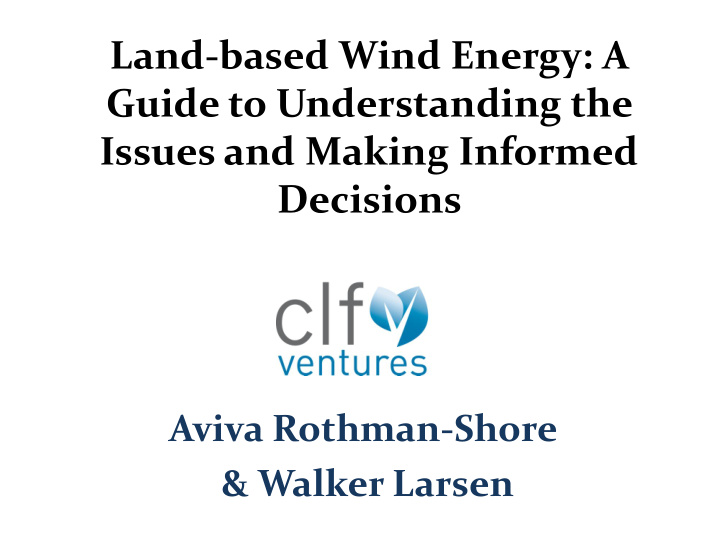



Land-based Wind Energy: A Guide to Understanding the Issues and Making Informed Decisions Aviva Rothman-Shore & Walker Larsen
Who we are • The non-profit consulting affiliate of Conservation Law Foundation, a New England environmental advocacy organization • We work in collaboration with public and private organizations to advance sustainable innovation and bring about positive environmental change
Collaboration with MassCEC • Facilitated 3 interactive regional conversations with municipal officials & volunteers – Theme of “ What will help us make robust decisions about wind power in our communities?”
Regional Meetings: Content Take-Aways Cape and Islands Western MA North Shore Need to balance local Need to balance local Regional coordination on control with regional control with State’s role implementation (e.g., and state coordination regional utility) Need for better local Important role for Would help to have a and regional regional planning repository of information collaboration and agencies and experiences (model communication bylaws, etc.) State could help by Need for more Explore opportunities for commissioning neutral information small-scale wind studies
• Produced resource guide on land-based wind energy siting for a lay audience – How to make sense of information about wind energy – Literature review in 5 issue areas – Public Engagement in the Siting Process
How to make sense of information about wind energy • What are the authors’ credentials? • Are the conclusions based on documented, factual information from other sources you know and trust? • How current is the information? For web material, when was it posted and/or last updated? • Is there broad consensus regarding the information presented, or is it based on the conclusion of one individual or one study? • How generalizable is the information? • If the information is anecdotal, what are some of the key features that make it comparable to, or distinguish it from, a project you may be considering? • How representative is the information of the views and experiences of all people who might be affected positively or negatively by a particular project?
Sound and Health • The issue: Some people have stated that inaudible sound created by wind turbines can cause physiological health impacts. • More information: – Sounds at frequencies below 200 Hz are referred to as “low frequency sound”; when low frequency sound drops below 20 Hz it is commonly called infrasonic sound, or infrasound – infrasound is generally below the threshold of human hearing, but may be audible when produced at more than 70 decibels – People have stated that they can feel vibrations or pressure, which they attribute to wind turbines, and these tangible impacts have come to be associated with low frequency sound and infrasound by some stakeholders.
Visual Impacts and Health • The issue: Some people living near wind turbines have reported experiencing negative health impacts, such as headaches and dizziness, which they attribute to shadow flicker from the turbines. • More information: – No studies in the epidemiology or medical literature have reported that shadow flicker from utility-scale wind turbines is harmful to health. – It is important to identify potential flicker effects during the design phase of a wind project and employ tools to help mitigate flicker or manage it. – There are no documented cases of epileptic seizures caused by shadow flicker from utility-scale wind turbines, and the risk of such an event occurring is negligible
A Guide to Understanding the Issues and Making Informed Decisions • Not all information is equal and it is important to compare apples to apples • Need to engage stakeholders early and often • Need to engage in serious discussion of issues of concern
Thank you! • For more information, contact: Aviva Rothman-Shore or Walker Larsen Arothman-shore@clf.org wlarsen@clf.org • To access the resource guide Land-based Wind Energy: A Guide to Understanding the Issues & Making Informed Decisions visit: www.clfventures.org/docs/wind_guide.pdf
Recommend
More recommend